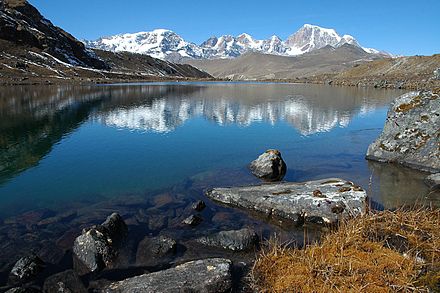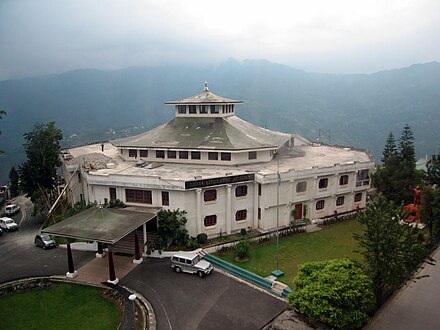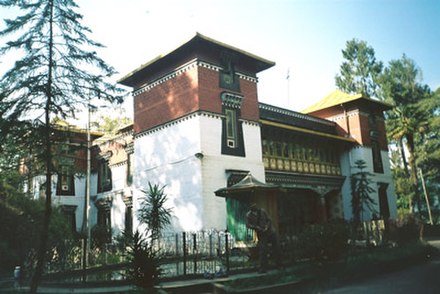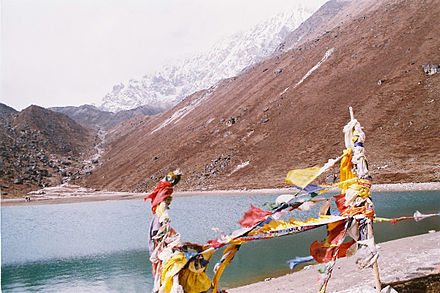Sikkim - state in northeastern India
Sikkim (Nepali: सिक्किम; Sikkimese: སུ་ཁྱིམ་) in East India, is a mountainous border state in the Himalayan foothills. It is bounded by China (Tibet), Nepal and Bhutan to its north, west and east respectively, with West Bengal forming its southern border. It is a place of great natural beauty. The steep, snow-capped mountains will take your breath away, not just figuratively because of the view, but also literally due to their altitude. Through its deep valleys flow two important rivers, rapidly in the north, getting somewhat sluggish in the south. Streams and waterfalls that will have you reaching out to your camera can be found at every turn of the winding ghat roads.
Apart from its natural beauty, Sikkim has much to offer. Monasteries offer you a glimpse of Tibetan Buddhist culture. The food, reflecting Tibetan and Nepali cultures, is great.
The name Sikkim is said to have been derived from su him, meaning "beautiful home", which makes sense as it is beautiful and the people will make you feel at home. Getting to this place is a bit of a challenge though, due to poor connectivity and because it borders China. Non-Indians need permits to enter, and getting to the northern parts presents additional difficulties. You will find the mostly friendly presence of the Indian Army and the border guards everywhere. That said, Sikkim is home to the only open border crossing between India and China, though this crossing is only open to traders and not to tourists.
Regions
Till December 2021, Sikkim was divided into 4 administrative districts, rather imaginatively called North, South, East and West.
The last two have been sub-divided since, forming two new districts. The official names of the original ones have been changed; now they are called by the names of the town where the district headquarters are. This guide continues to use the previous sub-division, as it is more relevant for the traveler. East Sikkim
Comprising of the Gangtok and Pakyong districts, this is the most populous region of the four. It borders both China and Bhutan.
Now renamed Mangan after its district headquarters, this region is even more mountainous than the rest of the state. The scenic Yumthang valley and the pretty Gurudongmar lake are some of its attractions. Entry restrictions are higher and travel is tougher here.
Now known as Namchi district, South Sikkim is warmer and has fewer mountains.
This region now comprises the administrative districts of Gyalshing and Soreng. The region borders Nepal and is a great place for trekking. Pelling, in this region, has monuments of historic significance.
{{mapshape|type=geoshape|fill=|title=East Sikkim|wikidata=Q1772832}} {{mapshape|type=geoshape|fill=|title=North Sikkim|wikidata=Q1784149}} {{mapshape|type=geoshape|fill=|title=South Sikkim|wikidata=Q1805051}} {{mapshape|type=geoshape|fill=|title=West Sikkim|wikidata=Q611357}}
Towns
-
Gangtok 📍 — Capital of Sikkim. Located in the East Sikkim district
-
Geyzing 📍 — District head-quarters of West Sikkim district
-
Mangan 📍 — District head-quarters of North Sikkim district
-
Namchi 📍 — District head-quarters of South Sikkim district
-
Pelling 📍 — Located in West Sikkim district offers great views of snow covered Kanchenjunga
-
Ravangla 📍 — Located in South Sikkim district
-
Yuksom 📍 — Located in West Sikkim district, first capital of Sikkim
Other destinations
-
Khangchendzonga National Park 📍 — there are many glaciers located in the park. Animals such as musk deer and snow leopard make there homes here
-
Dzongu 📍 — In North Sikkim, region reserved for the Lepcha People.
-
Silk Route 📍 — A high altitude road trip in East Sikkim district. The road meanders past high altitudes lakes and passes offering great views of snow covered Kanchenjunga
Understand
Sikkim covers an area of about 7,300 square kilometres, nearly 40% of which is forested. Kanchenjunga (8,586 m) is the third-highest mountain on earth. The mountain is venerated as seat of the Gods. Sikkim is renowned for wide rhododendron woods with 450 different kinds of orchids. The orchids blossom from March to May.
History
 For a long time, Sikkim was a Buddhist kingdom, isolated in the Himalayas, populated by Lepchas and Bhotia, two tribes of Tibetan origin, and governed by the Namgyal Dynasty from Tibet. Sikkim was declared a British protectorate in 1861. The British government encouraged the immigration of Nepalese workers, and today about 75% of the population is Nepalese. Sikkim was an Indian protectorate from 1947 until 1975, when after a couple of years of unrest, a referendum criticized by some resulted in overwhelming approval of a proposal to abolish the monarchy (which had continued to rule during Sikkim's years as a protectorate), and Sikkim later that year became the 22nd federal state of India.
For a long time, Sikkim was a Buddhist kingdom, isolated in the Himalayas, populated by Lepchas and Bhotia, two tribes of Tibetan origin, and governed by the Namgyal Dynasty from Tibet. Sikkim was declared a British protectorate in 1861. The British government encouraged the immigration of Nepalese workers, and today about 75% of the population is Nepalese. Sikkim was an Indian protectorate from 1947 until 1975, when after a couple of years of unrest, a referendum criticized by some resulted in overwhelming approval of a proposal to abolish the monarchy (which had continued to rule during Sikkim's years as a protectorate), and Sikkim later that year became the 22nd federal state of India.
Though it had long been the subject of a territorial dispute between China and India, in 2003, China agreed to recognise Indian sovereignty over Sikkim in return for Indian recognition of Chinese sovereignty over Tibet.
Talk
The official language and lingua franca of Sikkim is Nepali, though Sikkimese is the most common native language of locals. Many other languages such as Dzongkha and Tibetan are also spoken by smaller numbers. However, Hindi is also widely spoken as a second language, and all educated people are able to speak English.
Get in

By plane
Pakyong in Gangkok is the most convenient airport, but offers limited flight options. Bagdogra Airport in Siliguri (a three to four hour drive) is connected to most major Indian cities and also has twice-weekly international flights from Paro and Bangkok.
= By road =
Frequent buses and jeeps ply the routs to Gangtok and other parts of Sikkim from Siliguri. Otherwise, there is helicopter service from Bagdogra.
Entry permits to Sikkim
As of May 2015, it is still necessary to obtain a Restricted Area Permit (also known as Inner Line Permit - ILP) for foreigners, or a Protected Area Permit for Overseas Citizens of India, to travel in Sikkim. The permit is a piece of paper containing your passport data and dates you are permitted to travel (typically, 15 days). When entering and exiting Sikkim, your passport will be stamped much in the same manner as when crossing national borders. Obtaining a permit is a pure bureaucratic formality and usually takes a few minutes. You will need to fill in an application form and provide a few passport photos (3 to visit tsomgo Lake in East and 3 to visit North Sikkim).
The permit can be obtained when crossing the Sikkim state border by road in Rangpo or Meili and from the Sikkim Tourism Centre in Siliguri located at the S.N.T. bus stand (the place from which government buses depart for Sikkim: S.N.T. means "Sikkim Nationalized Transport") in the vicinity of Siliguri Junction railway station (different from New Jalpaiguri station, and reachable from there by taxi/public shared taxi). The website of Ministry of Home Affairs states that permits can also be obtained at large international airports (Delhi, Mumbai, Chennai, Kolkata), but locating the relevant facilities has proven difficult for some travellers, due to incompetence of personnel. Permits can also be applied for at the time of Indian visa application, or at 14 Panchsheel Marg, New Delhi 110021 (011 26115346) and 4/1 Middleton Street, Kolkata 700071 (033 22817905). Within India Inner Line Permits may be issued by:
- Sikkim House, 12-14 Panchsheet Marg, Chanakyapuri, New Delhi (Tel.011-2611 5346),
- Sikkim Tourist Centre, SNTC Bus Stand, Hill Cart Road, Silguri (Tel.0354-251 2646),
- Sikkim Tourist Information Centre, Sikkim House, 4/1 Middleton St., Kolkata (Tel. 033-2281 7905)
- Foreign Regional Registration Office in Delhi, Mumbai, Kolkata, Chennai, Darjeeling.
The permit is valid for 2 weeks from the border entry to Sikkim. It can by extended for 2 additional weeks at the Foreigners' Registration Office, Kazi Road, Gangtok (Tel. 03592-223041) or from the police station at Mangan, Gyalshing or Namchi The Inner Line Permit allows travels in Southern Sikkim and great parts of Eastern and Western Sikkim with the exception of treks in high mountain areas.
For the border regions, e.g. Tsomgo Lake in East Sikkim, most parts of North Sikkim and treks into high mountain regions, including Dzongri and Singalila Ridge a Protected Area Permit (PAP) is required. Foreigners must visit these regions in groups of at least 2 persons accompanied by a representative of an officially acknowledged tour operator. The agency will also apply for the Protected Area Permits.
Certain regions, e.g. Nathu La in East Sikkim or Gurudongmar Lake in North Sikkim, cannot be visited by foreigners.
By plane
Sikkim's first airport at Pakyong has been opened, with SpiceJet flying from Kolkata to Pakyong airport in East Sikkim and Guwahati In Assam and return flight to Pakyong and then to Kolkata- daily flights. There are plans for international service to Paro via Druk Air.
The nearest airport outside Sikkim is Bagdogra (IXB) in Siliguri in North Bengal, which is 124 km and approximately four hours drive from Gangtok. Air India, SpiceJet and Go Air service Bagdogra linking it with other major airports in India (including Guwahati). Druk Air flies twice weekly from Bangkok, stopping in Bagdogra before continuing to Paro in Bhutan. Sikkim is linked to Bagdogra airport by a daily helicopter service to Gangtok that operates only once a day and carries four passengers
- Air India offers daily flights from Delhi to Bagdogra, departure 11:15AM from Delhi, arrival 1:30PM at Bagdogra, and flights from Kolkata (CCU) daily except F departure from Kolkata 2:10PM, arrival at Bagdogra at 3:10PM. The return flight from Bagdogra to Delhi leave at 2:05PM and arrives in Delhi at 4:10PM, return flights to Kolkata depart from Bagdogra at 3:40PM and arrive in Kolkata at 4:40PM.
- Druk Air (Royal Bhutan Airlines) has flights from Bangkok (Thailand) and Paro (Bhutan) to Bagdogra. Flights from Bangkok leave on M and Th 8:55AM from Bangkok and arrive at 10:30AM at Bagdogra, flights to Bangkok leave Bagdogra on Sa and Tu at noon and arrive in Bangkok at 4:30PM. Flights from Paro leave Paro on Sa and Tu at 11:30AM and arrive at Bagdogra at 11:30AM, flights to Paro leave Bagdogra on Su and W at 11AM and arrive at Paro at 11:55AM.
- GoAir connects Bagdogra with Delhi and Guwahati on M W F and Su. Flights from Delhi go via Guwahati, they leave Delhi daily at 11AM. Flights from Guwahati leave Guwahati at 1:40PM and arrive at Bagdogra at 2.40 pm. The return flight goes directly to Delhi and departs at Bagdogra at 3:05PM and arrives in Delhi at 5:20PM.
- SpiceJet Airlines has daily flights from Delhi to Bagdogra, Flights leave Delhi at 11:15AM and arrive at Bagdogra at 1:25PM, return flights leave Bagdogra at 10:40AM and arrive in Delhi at 12:50PM.
By train
Construction of a 50-km rail link from Sevoke, West Bengal to Rangpo, Sikkim started in 2009, but is not expected to be ready until 2019, and it'll take another few years until it reaches another 40 km to Gangtok.
As of January 2021, the nearest railway station is New Jalpaiguri (NJP) in Siliguri, which is a major station with connections to major cities throughout and north and central India. The distance from Delhi to New Jalpaiguri by train is 1,970 km, and 580 km from Kolkata to New Jalpaiguri.
- 12502 Poorvottar Sampark Kranti Express to Guwahati leaves New Delhi Station on W Th and Su at 11:55PM and arrives at New Jalpaiguri 2 days later at 12:05AM.
- 12501 Poorvottar Sampark Kranti Express leaves New Jalpaiguri on Tu W and Sa at 1:30PM and arrives in New Delhi Station next day at 1PM.
- 12424 Dibrugarh Rajdhani Express to Dibrugarh Town leaves New Delhi Station daily at 2PM and arrives at New Jalpaiguri next day at 10.45 am.
- 12423 Dibrugarh Rajdhani Express leaves New Jalpaiguri daily at 1:15PM and arrives at New Delhi Station at 10:10AM next morning.
For details see the train schedule information of Indian Railways
You should be able to get pre-paid taxis to Gangtok outside the railway stations easily.
By bus
The Sikkim government has fixed rate (and fixed schedule) buses plying between Siliguri and Gangtok.
- There is a daily service from Darjeeling to Gantok and vice versa, operated by Sikkim National Transport (SNT). The distance between Darjeeling and Gangtok is about 120 km. Departure from both places at 8:30AM. Travel time 6 hr 30 min.
- Services from Siliguri to Gangtok and v.v. are operated by Sikkim National Transport (SNT) and North Bengal Transport (NBT). Busses leave Siliguri at 6 (NBT), 7, 9AM and 1PM (SNT), and Gangtok at 7 and 8AM (SNT), 12:30PM (NBT), 1PM (SNT). Travel time is 6 hrs.
The SNT bus stand at Gangtok is in Pajor Stadium Road. In many cases it is, however, more convenient to get off at MG Marg. The private bus stand is on National Highway NH-31A, about 2 km south of the city centre.
After 44 years of closure, the Nathu La pass to Tibet, China – a part of the historic Silk Road – opened again in July 2006. At the moment, only traders are permitted to cross the border here, and it is not open to tourists. Indian citizens require a permit to visit the Indian side of the pass, while foreigners are not permitted to visit.
Get around
Most travel in Sikkim is done by bus or jeep on road. Trekking is also a popular option.
See

Monasteries
- Bermoik Monastery. Built in 1952 for the Nyingma sect of Buddhism.
- Chawang Ani Monastery. Built during the reign of Chogyal Thutob Namgyal.
- Dalling Monastery. Built in 1840.
- Dodrul Chorten, Gangtok. Built in 1945-46 with a complete mandala set of Dorji Phurpa (Bajra Kilaya), a set of Ka-gyur holy Books, complete 'zung'(mantras) and many religious objects.
- Dubdi Monastery. The first monastery established after the consecration ceremony of the first chogyal. It is situated on a hill above Yuksom and can be approached by trekking only, including a steep slope taking about 35 minutes.
- Enchey Monasteyr, Gangtok. 200-year-old monastery, famous for the mask dance 'Cham' performed in January.
- Karma Kagyu Monastery, Phodong (32 km from Gangtok on the Gangtok Lachung Highway.). Built in 1740, the monastery is famous for its old wall murals.
- Kewzing Monastery. Built during the reign of Chogyal Thutob Namgyal.
- Khechepalri Monastery.
- Labrang Monastery. Built at the end of 19th cent, this monastery belongs to the Nyingmapa sect. The ruins of Tumlong, the third capital of Sikkim are nearby.
- Lachen Monastery. Built in 1806.
- Lachung Monastery. Built in 1880.
- Melli Monastery.
- Namchi Monastery. Constructed during the reign of Chogyal Gurmed Namgyal.
- Pal Zurmang Kagyud Monastery, Lingdum (on the Rumtek - Ranka - Gangtok road, about 45 min drive from Gangtok). A fine example of Tibetan monastic architecture.
- Pemayangtse Monastery (Perfect Sublime Lotus). 7AM to 7PM. The monastery was founded by Lhatson Champo, the protector of Sikkim. It is one of the most important monasteries in the country. There are pictures of Guru Rinpoche and Lhatsun Chenpo, thangkas and wall paintings in the big gompa, which is three storeys high,. The wooden sculpture on top represents Sang Phok Patri, Guru Rinpoche's abode in heaven. The abbot of the monastery carved and painted the sculpture himself. It is reported that he was working for 5 years on the representations of demons, animals, Buddhas and boddhisatvas. Every year at New Year (February/March) a great festival (cham) is held at the monastery. In 1980 the monastery founded the Denjong Padma Choeling Academy for orphans and children without means. ₹20
- Phodang Monastery. Built by the Chogyal Gyurmed Namgyal in the first quarter of 18th cent. It is considered one of the most beautiful monasteries in Sikkim. It has beautiful old mural paintings. Today, about 250 monks live there.
- Rhenock Monastery.
- Rumtek Monastery. – 24 km from Gangtok in East Sikkim – the main seat of the Karma Kagyu (Black hat) school of Tibetan Buddhism in Sikkim. This school was founded in the 12th cent. by Karmapa Duseun Khyenpa in Central Tibet. The 16th Karmapa Rangjung Rigpe Dorje had to leave Tibet in 1959 and was invited to stay at Rumtek. He was granted land by the king of Sikkim and erected a new monastery here. Karmapa Rangjung Rigpe Dorje is considered one of the greatest Tibetan personalities of the 20th cent and had great influence in spreading Tibetan Buddhism in the West. When he died in 1981 he left a rich monastery of international reputation. The new Rumtek monastery consists of the main temple, a golden stuoa, the Karma Shri Naranda Institute, some smaller shrines and a guesthouse. Foreigners have to show their passport and register. The prayer hall is ornamented with wall paintings and thangkas. A smaller room beside the main hall is painted in gold on a black background depicting angry deities. The Karma Shri Naranda Institute was built in 1984 in traditional Tibetan style. It is the most splendid building in the monastery. The ashes of the 16th Karmapa are kept in a guilded chorten, 4 m high, decorated with turquoise and corals. A path with flowers and prayer flags, at a distance of 4 km from the new monastery leads to the old monastery, which was built by the 9th Karmapa Wangchuk Dorje in 1740, but fell into disrepair.
- Sanga Chelling Monastery. The name literally means "the island of esoteric teaching." Built in 1697, it is the second oldest monastery in Sikkim.
- Sang Monastery. Built in 1912.
- Sangacholing Monastery. Erected in 1697, it is considered one of the oldest monasteries in Sikkim. It is on a steep hilltop and can only be accessed by a 40 min trek through the forest.
- Simik Monastery.
- Tashiding Monastery. It is considered as the holiest monastery in Sikkim. It is situated on a cone-shaped mountain, 19 km south-east of Yoksum. It was erected in 1717, according to the legend on a place which was connected with the peak of Kanchenjunga by a rainbow. The monastery consists of several stupas (corten), chapels and the main temple. The relics of the lamas of Sikkims are preserved in a number of smalles chorten. The Nyingmapa-Buddha-Festival is celebrated in the monastery on the 15th day of the first month of the Tibetan moon calendar.
- Tsuk-La-Khang Monastery, Gangtok. It was used for royal weddings and coronations.
- Yangyang Monastery. Built in 1840
Scenery

- Baba mandir. Eight kilometers from Nathu la pass is the original Harbhajan Singh Baba Temple from which the Indo-Bhutan border is approximately 6 km and the India-China border is around 5 km. A must visit place for all those who like to explore places!
- Chungthang. Chungthang is in the northern part of Sikkim. It is located at the confluence of Lachen and Lachung Chu and is the starting point of the river teesta. It is believed that Chungthang is blessed by a guru Rimpoche.
- Gurudongmar Lake. Gurudongmar lake is at an altitude of 5,150 metres. The lake is considered sacred. It has crystal clear waters and the way leading to it is a cold desert. The lake is frozen during winter, except for a small part which is considered to be touched by Guru Padmasambhava. Visits to the lake are allowed after obtaining a permit from the Government. Foreign nationals are not allowed to go there. The whole area is controlled by army, due to its proximity to China. The air pressure is only 55% compared to sea level, making altitude sickness a certain outcome for any longer stay without lengthy acclimatisation. For day trip visitors a night stay at Lachen is advised to allow altitude acclimatisation. It is recommended that visitors do not run or speak loudly, rather sit by the lake enjoying its beauty and the surrounding mountains. Tourists are generally asked to leave the place by 1-2PM, after which the wind speeds picks up and is enough to carry small stones.
- Kabi Lungstok. Kabi Lungtsok is a historic place, located on North Sikkim Highway, 17 km away from Gangtok. This is the same place where the historic treaty between Lepcha Chief Te-Kung-Tek and the Bhutia Chief Khey-Bum-Sar was signed ritually.
- Nathu la pass. The Nathu la pass lies on the Sino-Indian border and is only open for Indian tourists. People who wish to visit Nathu la should get special permission one day in advance. Please note, however, that the pass is not open on Mondays & Tuesdays every week.It closes in the winter and opens in May.
- Tsongmo Lake. 40 km from Gangtok in East Sikkim on Nathula route – Tsongmo Lake (also called Changu Lake or Tsomgo Lake) is a large lake in the East Sikkim district of India. It is oval-shaped, with a length of about one kilometre and has an average depth of fifteen metres.It is also a home of Brahminy Ducks besides being a stopover for various migratory birds. Etymologically "Tso" means lake and "Mgo" means head, thus literally meaning "source of the lake" in the Bhutia language. Tsongmo lake is declared a sacred lake by the local Buddhist and Hindu population. The lake remains hidden in the rich forest cover. It is believed that the birds do not permit even a single leaf to float on the lake surface. There is a motorable road from Pemayangtse right up to the lake area. It falls in the restricted area and hence an inner line permit is required by Indians to visit this place. Foreign nationals are not permitted to visit this lake without special permission. A little distance from the lake is a beautiful natural three storied cave, the Tseten Tashi Cave is a worth to visit. 2018-07-21
Do
 There are many adventure activities possible to do in Sikkim. Tourists can go for trekking, rafting and kayaking, mountain biking, mountaineering Para Gliding and yak safaris.
There are many adventure activities possible to do in Sikkim. Tourists can go for trekking, rafting and kayaking, mountain biking, mountaineering Para Gliding and yak safaris.
Trekking
Trekking is a popular adventure activity in Sikkim. Some of the popular trek routes are:
- Dzongri - Gechala Trek: The 8 - 9 day trek leads to the base of Kanchenjunga, the third highest peak in the world. The route passes through alpine forest, lush green meadows and past glacial lakes. People with lesser time can opt for the Dzongri trek (5 days) which provides great panoramic views of Kanchenjunga and its surrounding peaks.
- Maenam Hill Trek:Maenam (10,500 ft) is a hill towering above the town of Rabangla offering a great panoramic views of Kanchenjunga and its surrounding peaks. It is 3 - 4 hrs (one way) hike from Ravangla. Spending a night atop Maenam hill is a thrilling experience with a spectacular sunrise in the morning. There are no places to stay in Maenam Hilltop, so tents and food need to be carried.
White water rafting
Large stretches of the two major rivers of Sikkim, Teesta and Rangit are suitable for rafting.
Mountain biking
The experience of dangerous, yet exciting, sports like mountain biking is an enormous attraction for visitors who come to Sikkim to spend some days of relaxation in the touch of nature. So undoubtedly a place like Sikkim, where mountains are a prime part of the landscape, an off-road cycle ride through the uneven hills, jungles and water bodies works like a magnet for all who are obsessed with exploring new thrills.
Eat
 Delicious momos stuffed with meat (also known as 'Dumpling'). For vegetarians, veg momos are also available along with Thukpas (noodle soup). Phagshapa is a strip of pork fat stewed with radishes and dried chillies.
Delicious momos stuffed with meat (also known as 'Dumpling'). For vegetarians, veg momos are also available along with Thukpas (noodle soup). Phagshapa is a strip of pork fat stewed with radishes and dried chillies.
Drink
- Chhang/thumba/tongba/chee - Locally brewed mildly intoxicating millet beer, sometimes served in a bamboo glass with a wooden straw.
- HIT Beer - A local favourite manufactured by a brewery owned by the Bollywood actor Danny Denzongpa.
- Liquor - Whisky, brandy and rum are very cheap in Sikkim as compared to other parts of India.